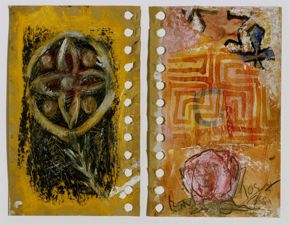Aqueous Abstractions: Contemporary American Watercolor and Gouache November 11, 2010–January 23, 2011

Jamie Bennett, Studies for "The Rose," from Rocaille, 1994, gouache, watercolor, and pencil on paper.
Brice Marden, Hydra, Summer 1990, I of V, 1990, ink and gouache on paper.
Aqueous Abstractions showcases watercolors and gouaches by contemporary American artists. Watercolor consists of pigment particles dissolved in water mixed with gum arabic, a natural gum made from hardened sap. Made into dry cakes or liquid stored in tubes, watercolor is diluted with water and is applied to paper with a brush. As the water evaporates, transparent layers of color become enmeshed with the surface of the paper, creating a luminous effect. Gouache, or watercolor blended with white pigment to make an opaque paint, dries on the surface of paper and is characterized by a matte finish.
Water-based painting techniques such as watercolor and gouache date back to antiquity. In the Middle Ages and Renaissance period, artists used these media for illustrative purposes. They became popular in England in the 18th and 19th centuries, after which American artists embraced them and experimented with their potentialities.
This exhibition illustrates how American artists have exploited the unpredictable nature of watercolor and gouache to produce abstract compositions. The media encourage spontaneity and improvisation, qualities these artists explored as a means of individual expression.
